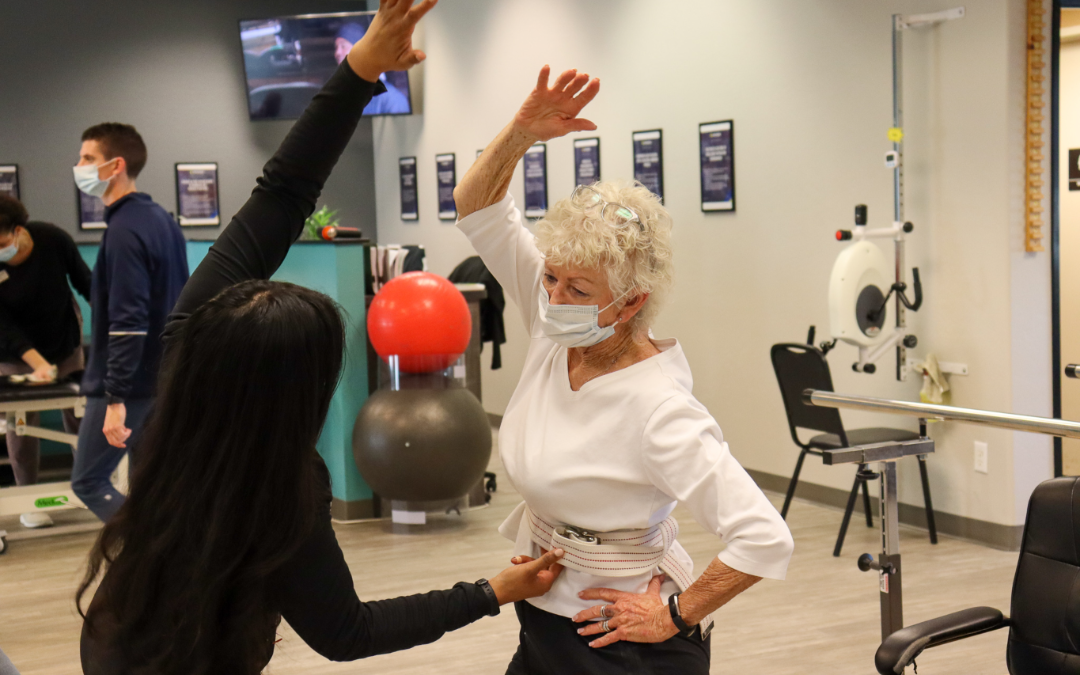As we develop as children, we acquire certain movements that help us in all aspects of life. From sitting, to standing, to rolling over in bed, or reaching overhead for the highest item on the shelf, we engage muscles and move in ways that we don’t necessarily think about unless we are injured or impaired.
With a disease like Parkinson’s, foundational movements begin to become harder as some of the major symptoms of the disease are rigidity, loss of balance, and tremors. Motions can take longer and become difficult to perform. However, there is hope of re-establishing those foundational movements.
PWR!Moves® is an exercise and wellness program that focuses on functionality for individuals with Parkinson’s Disease (PD). There are 4 basic PWR!Moves: PWR! Up, PWR! Rock, PWR! Twist, and PWR! Step. All of these moves work to improve postural awareness, weight shifting, mobility of the spine, and positional changes. We talked to Audra Crossland, PT, DPT, FAFS, about PWR!Moves and its effectiveness in focusing on improving functionality for those with Parkinson’s Disease.
What is PWR!Moves and how does it relate to the LSVT-BIG program?
“PWR!Moves gives you several building blocks to progress upon to promote large amplitude movements in functional ways to combat the effects of Parkinson’s Disease (PD). LSVT-BIG is a set protocol focused on specific large amplitude movements that lasts at minimum 1 hour a day, at least 4 days in a row for 4 weeks or more. There is a lot of overlap when it comes to specific movements or exercises from both PWR!Moves and LSVT-BIG. The biggest difference between the two programs is the focus on function and variety specific to the patient’s goals. PWR!Moves looks at movements performed daily and with activity.
According to Dr. Becky Farley, researcher and creator of both LSVT-BIG and PWR!, ‘PWR!Moves represents the EVOLUTION of amplitude-focused whole-body exercise from a specific repetitive protocol (LSVT-BIG) to a curriculum with a singular focus on the retraining of everyday movements while applying techniques to address multiple symptoms across disease severity. In other words, while staying focused on functional skill training, therapists can use their clinical reasoning to progress the physical or cognitive difficulty using different techniques shown to enhance learning to create personalize programs for people with different symptom distribution, interests, and access to exercise. So ideally you need a personalized exercise prescription. That is what we are training therapists to do with PWR!Moves.’”
Why is bridging the gap of neurological rehab and ortho rehab important for treating Parkinson’s Disease?
“Many, if not all, patients with Parkinson’s Disease also have their orthopedic concerns along with neurological needs. Due to the nature of PD, it affects the entire body and how it functions. Therefore, having a mindset focused on both neurological and orthopedic rehab needs provides the most thorough and complete physical therapy treatment for the patient.”
What are some key benefits of PT interventions?
“Physical therapy and exercise in general have been proven to be very effective in slowing and even stalling the progression of PD in patients. Research performed by the Parkinson’s Outcomes Project showed that increasing physical activity to at least 2.5 hours a week can slow Parkinson’s symptom progression. Physical therapists are specially trained to help people with PD with exercise prescription, patient and caregiver education, balance and gait training, pain, posture, functional tasks training (i.e., transfers, bed mobility), reducing falls risks, and improving fears related to falls that can be utilized throughout the progression of PD to optimize function and quality of life.
I aim to focus on meaningful function for my patients and improving their strength, mobility, coordination and overall ability to complete goals that are important to them.”
April is Parkinson’s Awareness Month! We want to help you move better and feel better with Parkinson’s. It is never too early to begin physical therapy. If you or a loved one has Parkinson’s Disease, schedule an appointment today with Audra to see if the PWR!Moves program is right for you.

